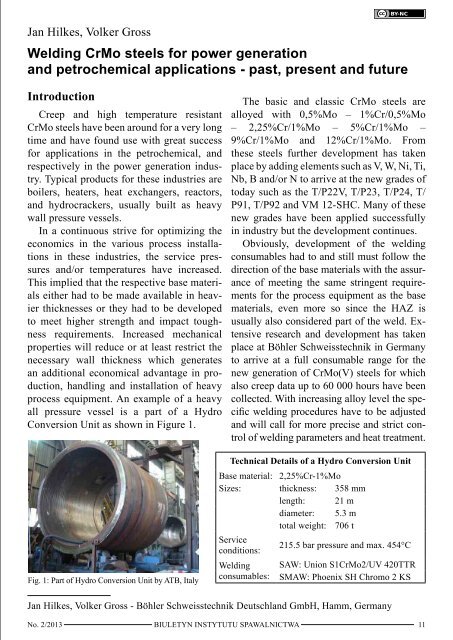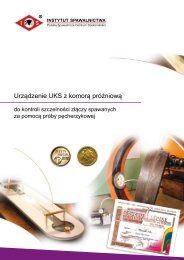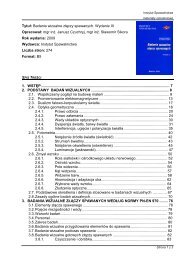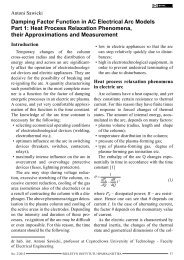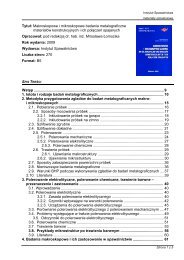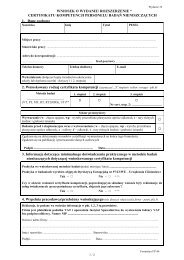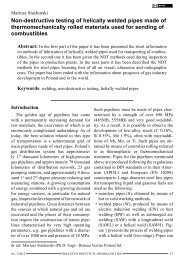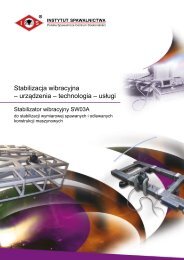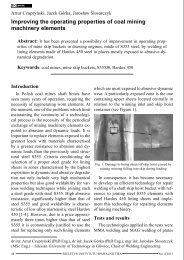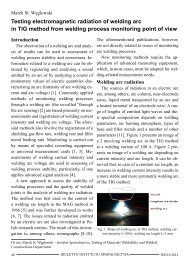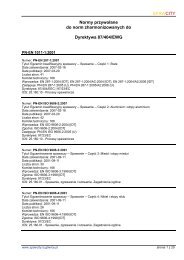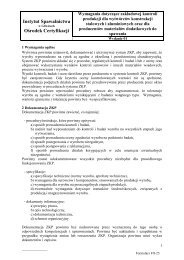Welding of CrMo steels for power generation and petrochemical ...
Welding of CrMo steels for power generation and petrochemical ...
Welding of CrMo steels for power generation and petrochemical ...
Create successful ePaper yourself
Turn your PDF publications into a flip-book with our unique Google optimized e-Paper software.
Jan Hilkes, Volker Gross<strong>Welding</strong> <strong>CrMo</strong> <strong>steels</strong> <strong>for</strong> <strong>power</strong> <strong>generation</strong><strong>and</strong> <strong>petrochemical</strong> applications - past, present <strong>and</strong> futureIntroductionCreep <strong>and</strong> high temperature resistant<strong>CrMo</strong> <strong>steels</strong> have been around <strong>for</strong> a very longtime <strong>and</strong> have found use with great success<strong>for</strong> applications in the <strong>petrochemical</strong>, <strong>and</strong>respectively in the <strong>power</strong> <strong>generation</strong> industry.Typical products <strong>for</strong> these industries areboilers, heaters, heat exchangers, reactors,<strong>and</strong> hydrocrackers, usually built as heavywall pressure vessels.In a continuous strive <strong>for</strong> optimizing theeconomics in the various process installationsin these industries, the service pressures<strong>and</strong>/or temperatures have increased.This implied that the respective base materialseither had to be made available in heavierthicknesses or they had to be developedto meet higher strength <strong>and</strong> impact toughnessrequirements. Increased mechanicalproperties will reduce or at least restrict thenecessary wall thickness which generatesan additional economical advantage in production,h<strong>and</strong>ling <strong>and</strong> installation <strong>of</strong> heavyprocess equipment. An example <strong>of</strong> a heavyall pressure vessel is a part <strong>of</strong> a HydroConversion Unit as shown in Figure 1.The basic <strong>and</strong> classic <strong>CrMo</strong> <strong>steels</strong> arealloyed with 0,5%Mo – 1%Cr/0,5%Mo– 2,25%Cr/1%Mo – 5%Cr/1%Mo –9%Cr/1%Mo <strong>and</strong> 12%Cr/1%Mo. Fromthese <strong>steels</strong> further development has takenplace by adding elements such as V, W, Ni, Ti,Nb, B <strong>and</strong>/or N to arrive at the new grades <strong>of</strong>today such as the T/P22V, T/P23, T/P24, T/P91, T/P92 <strong>and</strong> VM 12-SHC. Many <strong>of</strong> thesenew grades have been applied successfullyin industry but the development continues.Obviously, development <strong>of</strong> the weldingconsumables had to <strong>and</strong> still must follow thedirection <strong>of</strong> the base materials with the assurance<strong>of</strong> meeting the same stringent requirements<strong>for</strong> the process equipment as the basematerials, even more so since the HAZ isusually also considered part <strong>of</strong> the weld. Extensiveresearch <strong>and</strong> development has takenplace at Böhler Schweisstechnik in Germanyto arrive at a full consumable range <strong>for</strong> thenew <strong>generation</strong> <strong>of</strong> <strong>CrMo</strong>(V) <strong>steels</strong> <strong>for</strong> whichalso creep data up to 60 000 hours have beencollected. With increasing alloy level the specificwelding procedures have to be adjusted<strong>and</strong> will call <strong>for</strong> more precise <strong>and</strong> strict control<strong>of</strong> welding parameters <strong>and</strong> heat treatment.Fig. 1: Part <strong>of</strong> Hydro Conversion Unit by ATB, ItalyTechnical Details <strong>of</strong> a Hydro Conversion UnitBase material: 2,25%Cr-1%MoSizes: thickness: 358 mmlength: 21 mdiameter: 5.3 mtotal weight: 706 tServiceconditions:215.5 bar pressure <strong>and</strong> max. 454°C<strong>Welding</strong>consumables:SAW: Union S1<strong>CrMo</strong>2/UV 420TTRSMAW: Phoenix SH Chromo 2 KSJan Hilkes, Volker Gross - Böhler Schweisstechnik Deutschl<strong>and</strong> GmbH, Hamm, GermanyNo. 2/2013 BIULETYN INSTYTUTU SPAWALNICTWA11
Creep resistant <strong>CrMo</strong> <strong>steels</strong>Basic metallurgy <strong>for</strong> base material<strong>and</strong> weldmetal designCreep resistant <strong>steels</strong> are <strong>steels</strong> that canresist a certain stress at a specific servicetemperature without exceeding a specifiedamount <strong>of</strong> elongation. The maximum stressto rupture at a specific temperature after aspecific time, e.g. 600°C <strong>and</strong> 105 h, is referredto as Creep Rupture Stress. For example,an engineering design criterion <strong>for</strong> a<strong>power</strong> plant could require a minimal stress<strong>of</strong> 100MPa <strong>for</strong> 105 h at service temperature.The basic idea is that the vessel remains itsoriginal sizes <strong>and</strong> shape while in service <strong>for</strong>up to 20 to 30 years. Due to the fact that in theprocesses used within the Power Generation<strong>and</strong> Petrochemical Industry <strong>and</strong> the manydifferent service conditions such as pressure,temperature <strong>and</strong> environment, a widevariety <strong>of</strong> <strong>CrMo</strong> creep resistant <strong>steels</strong> withadditions <strong>of</strong> V, W, Ti, Nb, B <strong>and</strong>/or N havebeen developed, while new types are alsostill under development. Due to increasedpressures <strong>and</strong> temperatures, up to 370 bar<strong>and</strong> 650°C, as <strong>for</strong> example in components<strong>for</strong> Ultra-Super-Critical (USC) steam <strong>power</strong><strong>generation</strong> plants, <strong>CrMo</strong> creep resistantbase materials with increased strength arerequired to allow wall thicknesses that arewithin the range <strong>of</strong> what fabricators canh<strong>and</strong>le in their facilities. Also <strong>for</strong> <strong>petrochemical</strong>applications (P22V), sizes nowup to 350mm are no longer an exception.An overview <strong>of</strong> the international st<strong>and</strong>ards,chemical compositions <strong>and</strong> maximum servicetemperatures <strong>of</strong> the actual <strong>and</strong> mostpopular <strong>CrMo</strong> creep resistant <strong>steels</strong> is givenin Table 1.Table 1: Overview <strong>of</strong> the international st<strong>and</strong>ards, chemical composition <strong>and</strong> maximum service temperature<strong>of</strong> the actual <strong>and</strong> most popular <strong>CrMo</strong> creep resistant <strong>steels</strong><strong>CrMo</strong> typeINTERNATIONAL STANDARDSASTM & ASME DIN/VdTÜV EN0.5Mo T/P 1 16 Mo 3 8MoB 5-41.25Cr-0.5Mo T/P 11 10 CoMo 5-5 10 <strong>CrMo</strong> 5-51,00Cr-0.5Mo T/P 12 13 <strong>CrMo</strong> 4-5 13 CoMo 4-51.25Cr-1MoV - 15 <strong>CrMo</strong>V 5-10 -T/P 36 15 NiCuMoNb 5 (WB 36) 15 NiCuNb 52.25Cr-1Mo T/P 22 10 <strong>CrMo</strong> 9-10 10 <strong>CrMo</strong> 9-102.25Cr-1MoV T/P 22V - -2.25Cr-MoVW T/P 23 HCM 2S 7CrWVMoNb 9-62.25Cr-1MoVTiB T/P 24 7<strong>CrMo</strong>VTiB 10-10 7<strong>CrMo</strong>VTiB 10-105Cr-0.5Mo T/P 502 12 <strong>CrMo</strong> 19-5 -9Cr-1Mo T/P 9 X12 <strong>CrMo</strong> 9-1 X12 <strong>CrMo</strong> 9-19Cr-1Mo mod. T/P 91 X10 <strong>CrMo</strong>VNb 9-1 X10 <strong>CrMo</strong>VNb 9-19Cr-0.5MoWV T/P 911 X11 <strong>CrMo</strong>WVNb 9-1-1 X11 <strong>CrMo</strong>WVNb 9-1-19Cr-0.5MoWV T/P 92 X10 CrWMoNb 9-2 -12Cr-0.25Mo+1.4W1.3Co0.2V-X12 CrCoWVNb 11-2-2(VM 12-SHC) t
Heat treatments <strong>for</strong> <strong>CrMo</strong> <strong>steels</strong> <strong>and</strong>welded jointsThe heat treatments <strong>for</strong> the base materialsare reasonably complex but are requiredto obtain the optimal mechanical properties.Depending on the alloy content a Normalising,Tempering <strong>and</strong> Annealing treatment atvarious temperatures <strong>for</strong> several hours witha controlled cooling rate have to be executedaccording strict procedures. The same isvalid <strong>for</strong> the weldmetal, with increasing alloycontent the Post Weld Heat Treatment(PWHT) <strong>for</strong> welded joints gets more complicatedas illustrated in Figure 2.When in subsequent PWHT, IntermediateStress Relieving (ISR) or in service, the ultimateheat treatment temperature <strong>of</strong> the basematerial is exceeded too much <strong>and</strong> too long,the precipitations can dissolve again whichcauses reduction <strong>of</strong> the mechanical properties<strong>of</strong> the base material. This implies that,<strong>for</strong> example, <strong>for</strong> this reason the maximumtemperature <strong>of</strong> 760°C <strong>for</strong> P91 in Figure 2shall not be exceeded. For T/P23 in Figure2, an Intermediate Stress Relieving is indicated<strong>for</strong> constructions with different materialthicknesses. For each application the optimumPWHT shall be determined. Furtherelaboration will follow in the welding chapter<strong>of</strong> this paper (Table 4).Temper EmbrittlementWhen <strong>CrMo</strong> base material <strong>and</strong> the weldmetal is exposed to a temperature range <strong>of</strong>400-500°C <strong>for</strong> a very long time there is arisk <strong>of</strong> Temper Embrittlement. This type<strong>of</strong> embrittlement is caused by trace elementsas P, Sb, Sn <strong>and</strong> As that migrate to thegrain boundaries <strong>and</strong> can reduce the ductilityin both base material <strong>and</strong> weldmetal.To which extent this phenomena will occurdepends merely on temperature <strong>and</strong> time.Fig. 2: Temperature cycle <strong>and</strong> heat control duringwelding <strong>and</strong> PWHT <strong>of</strong> martensitic steel P91, E911 <strong>and</strong>P92 (above) <strong>and</strong> ferritic/bainitic steel T/P23 (below).For GTAW joints in
The Bruscato <strong>for</strong>mula, also referred to asthe X-factor, is valid <strong>for</strong> both weld metal <strong>and</strong>base material. For weldmetal the specificationsare becoming more <strong>and</strong> more stringentwith increasing wall thickness <strong>and</strong> desire<strong>for</strong> additional assurance <strong>of</strong> the mechanicalproperties. Initially, the required value <strong>of</strong> theX-factor was X < 15, but present specificationsalready ask <strong>for</strong> X < 10. An additionalrequirement <strong>for</strong> the Mn <strong>and</strong> Si content can beset accordingly: Mn + Si < 1.1%.Specifically <strong>for</strong> SAW where the trace elementscan be picked up from both wire <strong>and</strong>flux, the combination should be tested tocomply with the requirements. This meansone source <strong>for</strong> both wire <strong>and</strong> flux would berecommended /5/.Corrosion: Resistance to Oxidation,Sulphidation <strong>and</strong> Hydrogen attackIn addition to the creep resistance <strong>and</strong>resistance to embrittlement, <strong>CrMo</strong> <strong>steels</strong>also show increased high temperature oxidationresistance with increasing alloy content.Comparing the scaling loss <strong>for</strong> plaincarbon steel <strong>and</strong> 1%Cr0.5%Mo with that<strong>of</strong> 5%Cr0.5%Mo steel at 675°C, the scalingloss is reduced from >2.5 mm/y <strong>for</strong> thefirst two to about 0.1 mm/y <strong>for</strong> the latter.This makes these <strong>steels</strong> also very suitable<strong>for</strong> gas-fired furnaces in the <strong>petrochemical</strong>industry /6/.Also sulphidation corrosion resistance increaseswith increasing alloy content. Comparingthe corrosion rate <strong>of</strong> carbon steel withthat <strong>of</strong> 9%Cr1%Mo steel at 700°C, the corrosionrate is reduced from 1.0 to 0.2 mm/y.Sulphur combines with Chromium to <strong>for</strong>mChromium-Sulphides, <strong>and</strong> hence reduces theamount <strong>of</strong> Cr-carbides required <strong>for</strong> creep resistance.Since most crude oils <strong>and</strong> other gaseousfuels contain either certain amounts <strong>of</strong>Sulphur or H2S, sufficient sulphidation corrosionresistance is required <strong>for</strong> <strong>petrochemical</strong>installations.Another important phenomena is HighTemperature Hydrogen Attack (HTHA), a<strong>for</strong>mation <strong>of</strong> Methane from Cementite (Fe 3 C+ 2H 2 → CH 4 + 3Fe) in the base material underhigh Hydrogen pressures at high temperatures,as <strong>for</strong> example in heavy wall pressurevessels <strong>for</strong> high-temperature, high hydrogenservices in oil refineries. The 2.25%Cr1Mo<strong>and</strong> 3%Cr1Mo <strong>steels</strong> are typical base materialswith good resistance to HTHA in thisapplication.<strong>Welding</strong> <strong>and</strong> welding consumables<strong>for</strong> <strong>CrMo</strong> <strong>steels</strong>In general, creep resistant <strong>CrMo</strong>-<strong>steels</strong> arewelded with matching consumables in orderto have a homogeneous welded joint withabout equal mechanical properties. Matchingcompositions also have the same coefficient<strong>of</strong> thermal expansion, which preventsor at least reduces the risk <strong>of</strong> thermal fatiguein service. In this respect, the heat affectedzone (HAZ) is a vulnerable area.In principle, all arc welding processes canbe applied as SMAW. GTAW, GMAW, SAW<strong>and</strong> FCAW. For manual processes it is importantto take sufficient measures to protectthe welders from heat, <strong>and</strong> then it is <strong>of</strong> utmostimportance that the preheat as well asthe interpass temperatures are respected <strong>and</strong>not reduced to accommodate the welders, aswell as while tacking. With the gas-shieldedprocesses it is vital to assure proper shielding<strong>of</strong> the weld. Due to the high preheat, thegas-shield can be distorted <strong>and</strong> provide lessprotection as required. Special nozzles <strong>and</strong>gas cups are available to reduce the problem.Over the last decades, Böhler SchweisstechnikGermany has developed a wide range<strong>of</strong> welding consumables <strong>for</strong> welding <strong>CrMo</strong><strong>steels</strong> <strong>for</strong> the processes: SMAW, GTAW,SAW, GMAW <strong>and</strong> FCAW. A selection table<strong>for</strong> the respective welding consumables <strong>and</strong>welding processes <strong>for</strong> creep resistant <strong>CrMo</strong><strong>steels</strong> can be found in listed in Table 3.No. 2/2013 BIULETYN INSTYTUTU SPAWALNICTWA15
Table 3: Selection table <strong>for</strong> the respective welding consumables <strong>and</strong> welding processes <strong>for</strong> creep resistant <strong>CrMo</strong> <strong>steels</strong><strong>CrMo</strong> typeBASE MATERIAL WELDING CONSUMABLES FOR <strong>CrMo</strong> STEELSASTMSAW& EN SMAW GTAW GMAWASMEwire flux0.5Mo T/P 1 8MoB 5-41.25Cr--0.5Mo1.00Cr--0.5Mo1.25Cr--1MoVT/P 11T/P 12-- T/P 36- -2.25Cr--1Mo2.25Cr--1MoVT/P 22T/P22V10 <strong>CrMo</strong>5-513 CoMo4-515 <strong>CrMo</strong>V5-1015 NiCuNb5 (WB 36)20 MnMo-Ni 5-510 <strong>CrMo</strong>9-107<strong>CrMo</strong>-2.25Cr--MoVW T/P 23 WVMoNb9-62.25Cr--1MoV5Cr-0.5MoT/P 24T/P5029Cr-1Mo T/P 99Cr-1Momod.9Cr--0.5Mo-WV9Cr--0.5Mo-WV12Cr--0.25Mo+1.4W1.3Co0.2V12Cr-1Mo-NiVT/P 91T/P911T/P 92---7<strong>CrMo</strong>-VTiB10-1012<strong>CrMo</strong>19-5X12 <strong>CrMo</strong>9-1X10 <strong>CrMo</strong>-VNb 9-1X11 Cr-MoWVNb9-1-1X10CrWMoNb9-2X12 Cr-CoWVNb11-2-2(VM12--SHC)t
Table 4: Overview <strong>of</strong> typical guidelines <strong>for</strong> Preheat & Interpass temperatures <strong>and</strong> PWHT as SR, ISR <strong>and</strong> STC<strong>for</strong> <strong>CrMo</strong> <strong>steels</strong>. Also see Figure 2.<strong>CrMo</strong> typeASTM &ASMESTANDARDS0.5Mo T/P 1 8MoB 5-4 RT RT1.25Cr--0.5Mo1,00Cr--0.5Mo1.25Cr--1MoVT/P 11 10 <strong>CrMo</strong> 5-5T/P 12 13 <strong>CrMo</strong> 4-5T/P 36PREHEAT & INTERPASS TEMPERATURE, PWHT as SR, ISR<strong>and</strong> STC GUIDELINES <strong>for</strong> <strong>CrMo</strong> STEELSEN Tp °C Ti °C SR h, °C ISR h, °C PWHT/STC h, °C15 <strong>CrMo</strong>V 5-1015 NiCuNb 5(WB 36)21 MnMoNi 5-52.25Cr-1Mo T/P 22 10 <strong>CrMo</strong> 9-102.25Cr--1MoV2.25Cr-Mo-VW2.25Cr--1MoVT/P 22VT/P 23 7CrWVMoNb 9-6T/P 247<strong>CrMo</strong>VTiB 10-105Cr-0.5Mo T/P 502 12 <strong>CrMo</strong> 19-59Cr-1Mo T/P 9 X12 <strong>CrMo</strong> 9-19Cr-1Momod.9Cr-0.5Mo-WV9Cr-0.5Mo-WV12Cr-0.25Mo+1.4W1.3Co0.2V12Cr-1Mo-NiVT/P 91T/P 911T/P 92X10 <strong>CrMo</strong>VNb9-1X11 <strong>CrMo</strong>WVNb9-1-1X10 CrWMoNb9-2X12 CrCoWVNb11-2-2(VM 12-SHC)t 200°C 2-4h @660-700°C200-250°C > 200°C 2-4h @660-700°C200-250°C > 200°C 2-4h @660-700°C200-250°C > 200°C 2-4h @580-620°C200-250°C > 200°C 2-4h @580-620°C200-300°C200-300°C200-300°C200-280°C200-300°C200-250°C200-300°C200-280°C2-4h @670-720°C225-300°C > 225°C 2-4h @730-760°C200-300°C200-300°C200-300°C200-300°C200-280°C200-280°C200-300°C200-300°C200-300°C200-300°C200-280°C200-280°C* with great differences in wall thickness** no PWHT required <strong>for</strong> GTAW up to wall thickness <strong>of</strong> 10mmslow coolafter weldingslow coolafter weldingslow coolafter weldingslow coolafter weldingslow coolafter weldingslow coolafter welding1h @680°C1h @ 540-560°C*STC depending onapplication60h @ 550°C +40h @ 620°C8h @ 705°C + STC+32h @ 705°C0.5-4h @ 740°C**0.5-4h @ 740°C**xh@ 750°Cxh @ 730-780°Cxh @ 730-780°Cxh @ 770°Cxh @ 760°Cx dependson thicknessdepends also on the thickness <strong>of</strong> the construction<strong>and</strong> has to be determined by thefabricator as part <strong>of</strong> the welding proceduredevelopment. The main factor is to have acontrolled, slow <strong>and</strong> even heating up <strong>and</strong>cooling down to prevent additional stressesin the welded joint. For heavy thicknessesthis means heating up from as many sidesas possible to get the required heat distributionin the material. These precautions haveNo. 2/2013 BIULETYN INSTYTUTU SPAWALNICTWA17
to be taken to safeguard the base material,the weldmetal <strong>and</strong> the heat affected zone(HAZ).Recent developments in P22V, P23,P24, P92 <strong>and</strong> VM 12-SHC havegoverned more detailed <strong>and</strong> precisewelding <strong>and</strong> production proceduresto retain control over theoutcome <strong>of</strong> the final product. Althoughthese materials are not as<strong>for</strong>giving as the basic <strong>CrMo</strong> steel,the weldability is excellent whenthe correct procedures are followed.Depending on the application,there can be requirements<strong>for</strong> STC <strong>and</strong> Bruscato´s X- factor.For very heavy wall-thickness inP22V it could be necessary to applyintermediate stress relieving treatmentsas to reduce the overall stress level be<strong>for</strong>ethe final heat treatments applied. With theexperience that Böhler SchweisstechnikGermany has built up over the last decades,the support that can be provided to the customershas become a vital link in the supplychain in today’s business.As already mentioned, the thicknesses<strong>for</strong> a welded part in the <strong>power</strong> <strong>generation</strong><strong>and</strong> <strong>petrochemical</strong> industry keeps increasing<strong>and</strong> higher tensile strength materials,with more stringent mechanical properties<strong>and</strong> chemical composition, are used to keepfabrication feasible. This means that thewelding consumables have to be adapted t<strong>of</strong>ollow this trend.Figure 3 shows a very heavy wall example<strong>of</strong> a pipe connection <strong>of</strong> a live-steam pipe<strong>of</strong> P91 base material in a Power Station.Fig. 3: Weld preparation <strong>and</strong> final weld in a pipe connection<strong>of</strong> a live-steam pipe <strong>of</strong> P91, welded with SMAWusing Thermanit Chromo 9 VAs indicated the heat treatments includingpreheat <strong>and</strong> interpass temperature haveto be under strict control to successfullycomplete these types <strong>of</strong> welded joints. Thetemperature ranges <strong>for</strong> the preheat <strong>and</strong> interpasstemperatures given in Table 4 areto be respected throughout completion <strong>of</strong>the joint. For this application, SMAW isvery suitable due to its flexibility <strong>and</strong> lowinvestments regarding equipment. In orderto increase efficiency, higher weldmetaldeposition per unit <strong>of</strong> time, developmentis ongoing <strong>for</strong> FCAW consumables<strong>for</strong> <strong>CrMo</strong> <strong>steels</strong>. As listed in Table 3, anumber is already available but the rangewill be extended upon the dem<strong>and</strong> <strong>of</strong> theindustry.Technical Details <strong>of</strong> the Reactor:Base2,25%Cr-1%Momaterial:Fig. 4: Heavy wall Reactor in 2.25%Cr-1%Moby GODREJ, INDIAthickness:total weight:Serviceconditions:<strong>Welding</strong>consumables:124, 132 <strong>and</strong> 153 mmabout 500 t120 bar pressure <strong>and</strong> 437°CSAW: Union S1<strong>CrMo</strong>2/UV 420TTRSMAW: Phoenix SH Chromo 2 KS18 BIULETYN INSTYTUTU SPAWALNICTWANo. 2/2013
The SAW consumables range covers allthe <strong>CrMo</strong> <strong>steels</strong> available today. GTAW ismainly used <strong>for</strong> root welding or automatedwelding in dem<strong>and</strong>ing industries. TheGMAW range is available but not popular inthe Power Generation industry.Another practical example is that <strong>of</strong> a Reactorbuild in 2.25%Cr-1%Mo steel. Figure 4shows one <strong>of</strong> a number <strong>of</strong> these types <strong>of</strong> heavywall pressure vessels produced by Godrej inIndia. They have built up excellent <strong>and</strong> practicalexperience to be able to build such units.When dealing with heavy wall thicknesses,modern <strong>CrMo</strong> creep resistant <strong>steels</strong> <strong>and</strong> verystringent specifications, it is absolutely necessaryto build up sufficient experience tobe able to satisfy the dem<strong>and</strong>ing engineeringcompanies as well as the Oil <strong>and</strong> Power companies,who are the ultimate client.Parameter control <strong>and</strong> suggestions <strong>for</strong>“Best Practice”<strong>CrMo</strong>(V) weld metal typically shows abainitic/martensitic micro structure that respondvery sensitively to any kind <strong>of</strong> heatput in by means <strong>of</strong> welding <strong>and</strong> heat treatment.Furthermore, the high strength in theas welded condition requires accurate h<strong>and</strong>lingin terms <strong>of</strong> Hydrogen <strong>and</strong> ISR in orderto avoid cracking due to Hydrogen <strong>and</strong>/or therestrained condition <strong>of</strong> welds in heavy wallnozzles <strong>for</strong> example.To elaborate on some <strong>of</strong> the influences,typical observations in welds made in Cr-Mo(V) creep resistant <strong>steels</strong> are illustrated inthe next paragraph.Figure 5 shows ferrite precipitations inP11 due to excessive PWHT temperature.The micrograph in figure 6 shows Hydrogendamage due to a improperly applied soakingtreatment, leaving too much residual Hydrogenin the weldmetal. Figure 7 shows the effect<strong>of</strong> bead-thickness in SMA welds, a shift<strong>of</strong> the impact properties to higher temperatures,due to a much courser grain-structure.Applicable manufacturing parameters,which include the welding parameters as wellas the quality <strong>of</strong> the welding equipment <strong>and</strong>the skill-level <strong>of</strong> the welders, become moreimportant with an increasing initial strength.The “operating window” will become smaller.There<strong>for</strong>e suitable control mechanisms<strong>and</strong> procedures have to be set up to ensurethe proper application <strong>of</strong> the required parameters.In particular the control <strong>of</strong> the followingitems shall not be neglected <strong>for</strong> achievingsuccessful welds:• Selection <strong>of</strong> the suitable SAW wire & fluxcombination• Proper rebaking <strong>of</strong> fluxes <strong>and</strong> electrodes• Verification <strong>of</strong> preheating & interpasstemperatures• Setting <strong>of</strong> the electrical welding parameters• Weld build-up <strong>and</strong> beadsequence• Verification <strong>of</strong> the heat treatment temperature.Almost all issues encountered in <strong>CrMo</strong>welds could be related to the non-observanceFig. 5. Ferrite precipitations in P11 SA weldsFig. 6. Crack surface due to Hydrogen in P22V SA weldsNo. 2/2013 BIULETYN INSTYTUTU SPAWALNICTWA19
Table 5: Overview <strong>of</strong> typical applications <strong>of</strong> <strong>CrMo</strong> <strong>steels</strong> in the Power Generation & Petrochemical IndustryBASE MATERIAL INDUSTRIAL APPLICATIONS Service<strong>CrMo</strong> type ASTM &max. TEN POWER GENERATION PETROCHEMICALASMEin °CPressure vessels; Rp0.2 >0.5Mo T/P1 8MoB5-4Pressure vessels < 460290 MPa, Rm > 500 MPa1.25Cr--0.5Mo1.00Cr--0.5Mo1.25Cr--1MoVT/P11 10<strong>CrMo</strong>5-5 Steam headersT/P1213CoMo4-5- 15<strong>CrMo</strong>V5-10Water walls;parts <strong>of</strong> evaporaterMain steam pipe; reheatersteam pipe; Rp0.2 > 440MPa, Rm 590-780 MPaHeavy Wall PressureVessels, Coke Drums,Hydr<strong>of</strong>iner Reactors, CatalyticRe<strong>for</strong>mer Reactors< 535< 545Heat exchangers < 545- T/P3615NiCuNb5(WB 36)Feed water pipe High pressure steam drums < 545- - 20MnMoNi5-5 Reactor vessels (nuclear) -2.25Cr-1Mo T/P22 10<strong>CrMo</strong>9-102.25Cr--1MoV2.25Cr-Mo-VW2.25Cr--1MoVT/P22V -T/P23T/P247<strong>CrMo</strong>-WVMoNb9-67<strong>CrMo</strong>-VTiB10-10Parts <strong>of</strong> superheaters;Rp0.2 > 310 MPa,Rm 515-690 MPaRp0.2 > 415 MPa,Rm 585-760 MPa -->Parts <strong>of</strong> superheater;membrane wallsParts <strong>of</strong> superheater;membrane walls5Cr-0.5Mo T/P502 12<strong>CrMo</strong>19-5 -9Cr-1Mo T/P9 X12<strong>CrMo</strong>9-1 -9Cr-1Momod.9Cr-0.5Mo-WV9Cr-0.5Mo-WV12Cr--0.25Mo+1.4W1.3Co0.2V12Cr-1Mo-NiVT/P91T/P911T/P92--X10<strong>CrMo</strong>-VNb9-1X11<strong>CrMo</strong>-WVNb9-1-1X10CrWMoNb9-2X12CrCo-WVNb11-2-2(VM12-SHC)t 450 MPa,Rm 630-790 MPaSteam headers,superheatersSteam headers,superheaters <strong>for</strong> UltraSuper Critical boilersSuperheater tubes withthickness < 10mmSteam headers,superheaters;Rp0.2 > 500 MPa,Rm 700-850 MPaHigh Pressure &High TemperatureReactors, coke drums,furnaces, pipingHydrocrackers, Heavy WallPressure Vessels<strong>for</strong> Hydrogen Service< 535< 482- < 550- < 550Pressure vessels in high temperaturesulfur corrosion, resistancereactor furnaces <strong>and</strong> reactorsReactors, High TemperatureSulphur corrosion resistance,furnaces <strong>and</strong> pipingHigh pressure steam headers& piping< 550< 585< 585- < 625- < 625- < 650Tubing in H2S environments < 585High Pressure, HighTemperature & Corrosion20 BIULETYN INSTYTUTU SPAWALNICTWANo. 2/2013
Fig. 7. Influence <strong>of</strong> weld build-up on impact toughness<strong>of</strong> the above mentioned items. Consequentlysuitable control mechanisms have to bedeveloped to ensure proper welds. Qualityassurance becomes a major factor <strong>and</strong> mustbe included in the <strong>CrMo</strong> welding fabrication.QA has to be considered as an essential variable,as illustrated with Figure 8.In conclusion we can state that <strong>CrMo</strong>creep resistant <strong>steels</strong> are widely <strong>and</strong> successfullyapplied in the Power Generation <strong>and</strong>Petrochemical Industries. The developmenttowards higher service temperatures ask <strong>for</strong>new materials, both <strong>for</strong> base material as <strong>for</strong>welding consumables.To illustrate typical examples <strong>of</strong> wherethe various <strong>CrMo</strong> materials are applied,an overview <strong>of</strong> typical applications <strong>of</strong> <strong>CrMo</strong><strong>steels</strong> in the Power Generation <strong>and</strong> the PetrochemicalIndustry is given in Table 5.With this paper we intended to providean overview <strong>of</strong> the available materials, thest<strong>and</strong>ards, the consequences <strong>and</strong> the implicationswith regard to welding, heat treatments<strong>and</strong> fabrication. When the correct proceduresare developed up front <strong>and</strong> adheredto throughout the production, projects can be<strong>and</strong> have been successfully completed.References1. Cole D., Bhadeshia H.K.D.H.: Design<strong>of</strong> Creep-Resistant Steel Welds. Researchwork. University <strong>of</strong> Cambridge,Department <strong>of</strong> Materials Science <strong>and</strong>Metallurgy, 1998Fig. 8: QA to be included to verify required parameters2. Bhadeshia H.K.D.H: Design <strong>of</strong> Creep-ResistantSteels. Proceedings <strong>of</strong> Ultra-Steel2000. National Research Institute <strong>for</strong>Metals, Tsukuba, Japan 2000, pp. 89-1083. Bruscato R.: Temper Embrittlement <strong>and</strong>Creep Embrittlement <strong>of</strong> 2.25%Cr - 1%Moshielded metal arc weld deposits. <strong>Welding</strong>Journal 49 (4), 1973, pp. 148-1564. Watanabe J. et. al.: Temper Embrittlement<strong>of</strong> 2.25%Cr - 1%Mo Pressure VesselSteel. ASME 29 th Petroleum MechanicalEngineering Conference, Dallas,USA, 19745. Gross V., Heuser H., Jochum C.:Schweisstechnische Heraus<strong>for</strong>derung beider Verarbeitung von <strong>CrMo</strong>(V)-Stählenfür Hydrocracker. Publication <strong>of</strong> BöhlerThyssen Schweisstechnik, Germany,20076. H<strong>and</strong>el Geert van den: Chroom-Molybdeenstaalsoorten. Lastechniek, Nederl<strong>and</strong>sInstituut voor Lastechniek (NIL), No. 5,May 2008, pp.10-147. Gross V.: Improved toughness in2.25%Cr - 1%Mo(V) weldmetals <strong>for</strong> joiningheavy walled reactors. Publication<strong>of</strong> Böhler Thyssen Schweisstechnik,Germany, 2006.8. Fuchs R., Gross V., Heuser H., JochumC.: Properties <strong>of</strong> matching filler metals<strong>for</strong> the advanced martensitic <strong>steels</strong> P911,P92 <strong>and</strong> VM12. Proceedings <strong>of</strong> 5 th InternationalEPRI RRAC Conference, Alabama,USA, June 26-28, 2002No. 2/2013 BIULETYN INSTYTUTU SPAWALNICTWA21
9. Heuser,H, Jochum C.: Neue Schweisszusatzwerkst<strong>of</strong>fefür neue Kraftwerksstähle.Publication <strong>of</strong> Böhler ThyssenSchweisstechnik, Germany, 200410. Gross V, Heuser H., Jochum C.: NeuartigeSchweisszusätze für bainitische und martensitische.Publication <strong>of</strong> Böhler ThyssenSchweisstechnik, Germany, 200511. Valaurec, Mannesmann: Seamless boilertubes <strong>and</strong> pipes. Publication <strong>of</strong> Valaurec& Mannesmann Tubes, V&M 507-7e12. Hilkes J., Gross V.: Soldadura de los aceros<strong>CrMo</strong> para aplicaciones en la Generaciónde Energía y Petroquímica“-- Pasado, Presente & Futuro. CESOLConf. Proc. 1 er Congreso Internacional deSoldadura y Technologías de Unión (17 asJournadas Téchnicas), Madrid, Spain,7-9 October 2008., pp119-124.13. Hilkes J., Gross V.: Het lassen van <strong>CrMo</strong>stalen voor de Energieopwekking en dePetrochemische Industrie - Verleden,Heden en Toekomst. Dutsch & Belgium<strong>Welding</strong> Institute, NIL/BIL Lassymposium,Eindhoven, The Netherl<strong>and</strong>s, 26/26November 200822 BIULETYN INSTYTUTU SPAWALNICTWANo. 2/2013


